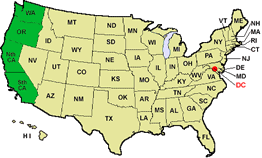| Pacific dampwood termites |
| Zootermopsis angusticollis |
This species ranges from Baja California and Mexico to British Columbia. They have been found up to 6,000 feet above sea level, but more commonly in the cool and humid coastal areas. Identification of Swarmers and Soldiers: Swarming may occur throughout the year, but most often from August through October. Swarming usually will occur on warm humid evenings just before sunset. The reproductives are strongly attracted to light. Swarmers are up to 1" in length and are light to medium brown with dark brown wings. Soldiers have a large head armed with long black toothed mandibles. The anterior portion is black generally shading to a dark reddish-brown in the posterior position. The abdomen and thorax are a light caramel color, the abdomen varying according to the stomach contents at the time. The largest termites in the United States, soldiers may be very large, reaching 5/8 to 3/4". Identification of Timber Damage: The tunnels vary greatly in size and shape and in sound timber may favour the softer springwood. Faecal pellets are found throughout the tunnels, and are hard small, oval and about 1/25 “ long. The color of the pellets may vary according to the type of wood being consumed. Biology and Habits: This species will attack wood of all types throughout its range. Timbers in contact with the soil or structures built near or over water are common targets. This species is known to be very tolerant of moist conditions, even being found in pilings subject to tidal flooding. Colony size varies but may contain as many as 4,000 individuals. Colony growth is aided by the production of secondary reproductives. Like other termites this species aid in the spreading of wood decay fungi, the spores of which are carried in the gut and on their bodies. A well established colony will produce winged reproductives which may infest nearby timber. The life history of the Pacific dampwood can be summarized as follows. Both male and female swarmers excavate a chamber, they enter, and the chamber is sealed. They mate and within about 2 weeks, eggs are laid and the colony is founded. The queen lays about 12 eggs. The second batch is laid the next spring. |
| About Termites in Your Local Area |
CLICK ON YOUR STATE: Alabama - Arizona - Arkansas - North California - South California - Colorado - Connecticut - Delaware - Florida - Georgia - Hawaii - Idaho - Illinois - Indiana - Iowa - Kansas - Kentucky - Louisiana - Maine - Maryland - Massachusetts - Michigan - Minnesota - Mississippi - Missouri - Montana - Nebraska - Nevada - New Hampshire - New Jersey - New Mexico - New York - North Carolina - North Dakota - Ohio - Oklahoma - Oregon - Pennsylvania - Rhode Island - South Carolina - South Dakota - Tennessee - Texas - Utah - Vermont - Virginia - Washington - Washington-DC - West Virginia - Wisconsin - Wyoming |
| Find out about latest termite control methods - Click here |
